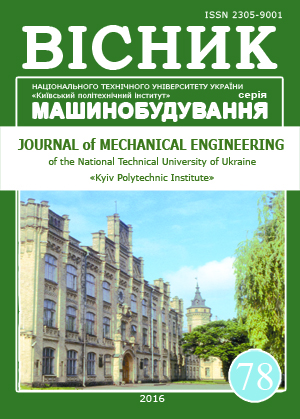DETERMINATION OF CUTTING TEMPERATURE WHILE MILLING TITANIUM ALLOY BY FACE MILLS
DOI:
https://doi.org/10.20535/2305-9001.2016.78.84954Keywords:
face mill, titanium alloy, temperature, modeling, cutting speedAbstract
In this article, the analysis process features high-speed cutting, which mainly attributed to the cutting temperatures depending on the speed of processing. Shows that depending on the design and tool size main criterion decrease temperature cutting not always characterized by high-speed processing. The reason for this is the rise temperature to values at which to change properties of the materials surface layer. To determine the cutting temperature of titanium alloys processing, we carried mechanical milling process simulation with mill Ø160 by finite element method. Defined temperature on contact surfaces at cutting speeds between 80 and 250 m/min. In this range of speed observed temperature cutting increase. Established, with cutting speeds higher 80 m/min workpiece surface have temperature at which the fragile layer formed. The simulation results verified experimentally in the milling of titanium alloy VT6.References
“High-speed processing: key to increase in productivity and quality” [Vysokoskorostnaja obrabotka: kljuch k povysheniju proizvoditel'nosti i kachestva], available at: http://engine.aviaport.ru/issues/67/page33.html.
Kostjuk, G.I., Postel'nik, T.A. and Voropaj, R.V. (2012), “Research of influence of speed of cutting and giving on efficiency of processing of the tempered steel shkh15”, Vestnik NTU “KPI”. Series: Technology in Engineering, no 53, рр. 127-135.
Kirjushin, D.E. and Nasad, T.G. (2005), “Processing by cutting of titanic alloys”, SHTU, рр. 105-108.
Kachan, A.Ja., Petrov, S.A., Panasenko, V.A., Mozgovoj, S.V. and Karas', G.V. (2006), “Technology of processing of axial monowheels high-speed milling”, Production technology of aircraft, no 1, pp. 12-18.
Jashhericyn, P.I., Fel'dshtejn, E.Je. and Kornievich, M.A. (2006), Teorija rezanija: ucheb [Theory of cutting: textbook], New knowledge, Minsk, Belorussia.
Kishurov, V.M., Krioni, N.K., Postnov, V.V. and Chernikov, P.P. (2009), Rezanie materialov. Rezhushhij instrument: ucheb. posobie [Cutting of materials. The cutting tool: manual], Mashinostroenie, Moscow, Russia.
Solovov, A. “High-speed processing” [Vysokoskorostnaja obrabotka], available at: http://www.obo-rt.ru/arhiv.
“High-speed processing” [Vysokoskorostnaja obrabotka], available at: http://www.delcam-ural.ru/cam/tehpodderjka.
“High-speed processing” [Vysokoskorostnaja obrabotka], available at: http://www.mirprom.ru.
Basharov, R.R., Kudojarov, R.G., Utkina, E.A., Grachev, M.S. (2015), “Research of high-speed turning of details from titanic alloy”, Space equipment, high technologies and innovations, no 1, рр. 126-129.
Escamilla, I., Zapata, O., Gonzalez, B. and Gámez, N. (2010), “Finite Element Simulation Of The Milling Process Of A TI6AL4V Alloy”, SIMULIA Customer Conference, Providence, USA.
Monno, M., Pittalà, G. and Linares, F. (2007), 3D Finite Element Modeling of Milling of Titanium, Proceeding of 10th CIRP International Workshop on Modeling of Machining Operations.
Korjagin, S.I., Pimenov, I.V. and Hudjakov, V.K. (2000), Sposoby obrabotki materialov: Uchebnoe posobie [Ways of processing of materials: Manual], Kaliningrad, Russia.
Kudrjavcev, I.V. (1967), Materialy v mashinostroenii. Vybor i primenenie [Materials in mechanical engineering. Choice and application], Mashinostroenie, Moscow, Russia.
Trusov, V.N., Skuratov, D.L., Zakonov, O.I. and Shikin, V.V. (2011), “Influence of the modes of cutting on temperature when milling preparations from the hardly processed materials”, Aviation and missile and space equipment, no 1, pp. 57-62.
Kirjushin, D.E. and Nasad, T.G. (2005), “Heatphysical features of use of the tools equipped with a wearproof covering for high-speed processing” [Teplofizicheskie osobennosti primenenija instrumentov, osnashhjonnyh iznosostojkim pokrytiem, dlja vysokoskorostnoj obrabotki], Heatphysical and technological aspects of quality management in mechanical engineering, Tolyatti.
Mazur, N.P., Vnukov, Ju.N. and Grabchenko, A.I. (2013), Osnovy teorii rezanija materialov: uchebnik [Bases of the theory of cutting of materials: textbook], in Mazur, N., Grabchenko, A. (ed.), Kharkiv, Ukraine.
Soltus, N. (2015), High-speed processing: current state of a question, in Tugolukova, A.V. (ed.), pp.105-112.
Schulz, H. and Moriwaki, T. (1992), “High Speed Cutting”, Annals of CIRP, Vol. 41, no 2, pp. 637-643.
“Identification of peak productivity at high-speed processing” [Vyjavlenie pikovoj proizvoditel'nosti pri vysokoskorostnoj obrabotke] available at https://www.plm.automation.siemens.com/ru_ru/Images/17610_tcm802-83550.
Jakimov, A.V., Slobodjanik, P.T. and Usov, A.V. (1991), Teplofizika mehanicheskoj obrabotki: Ucheb. posobie [Machining thermophysics: Manual], Lybid', Kiev, Odessa, 240 p.

